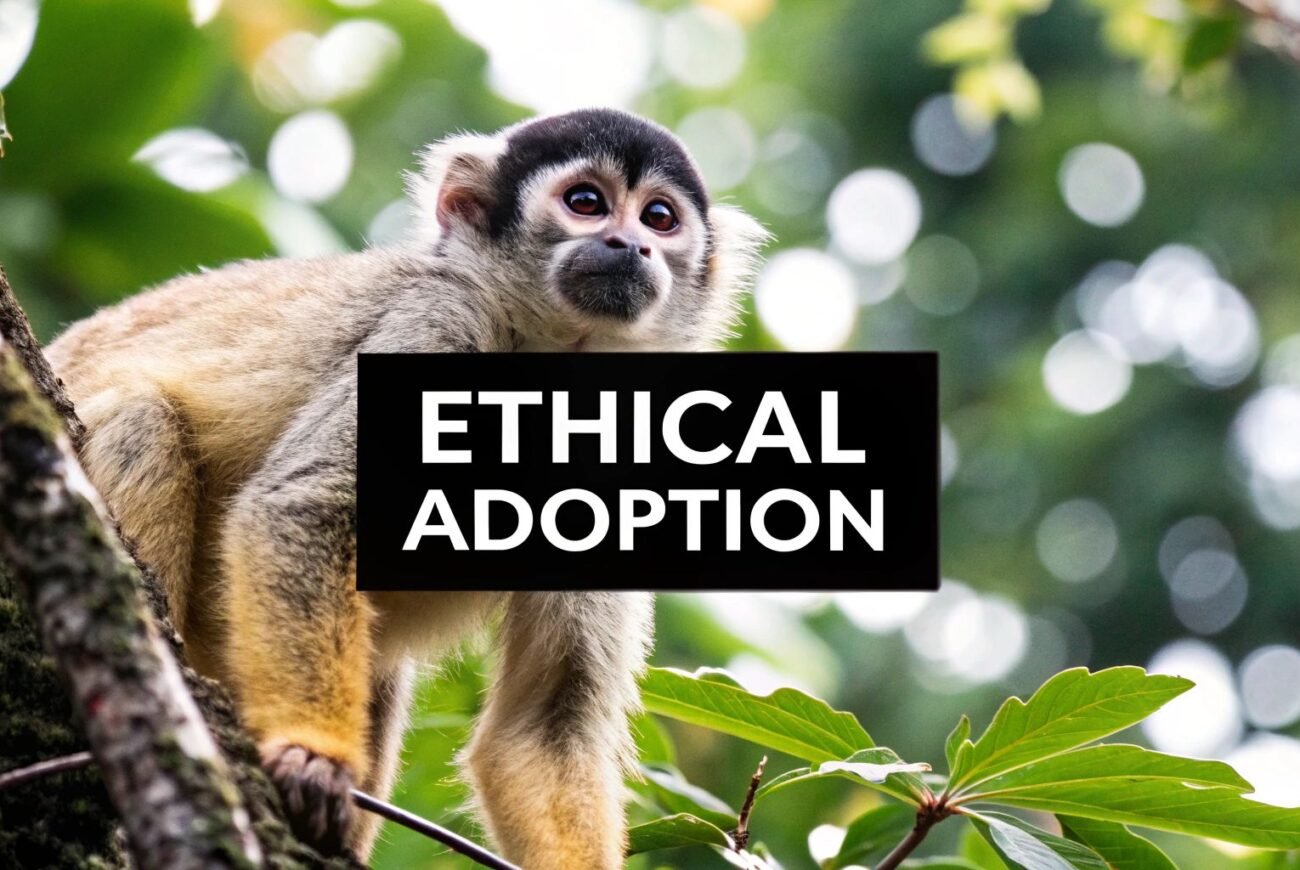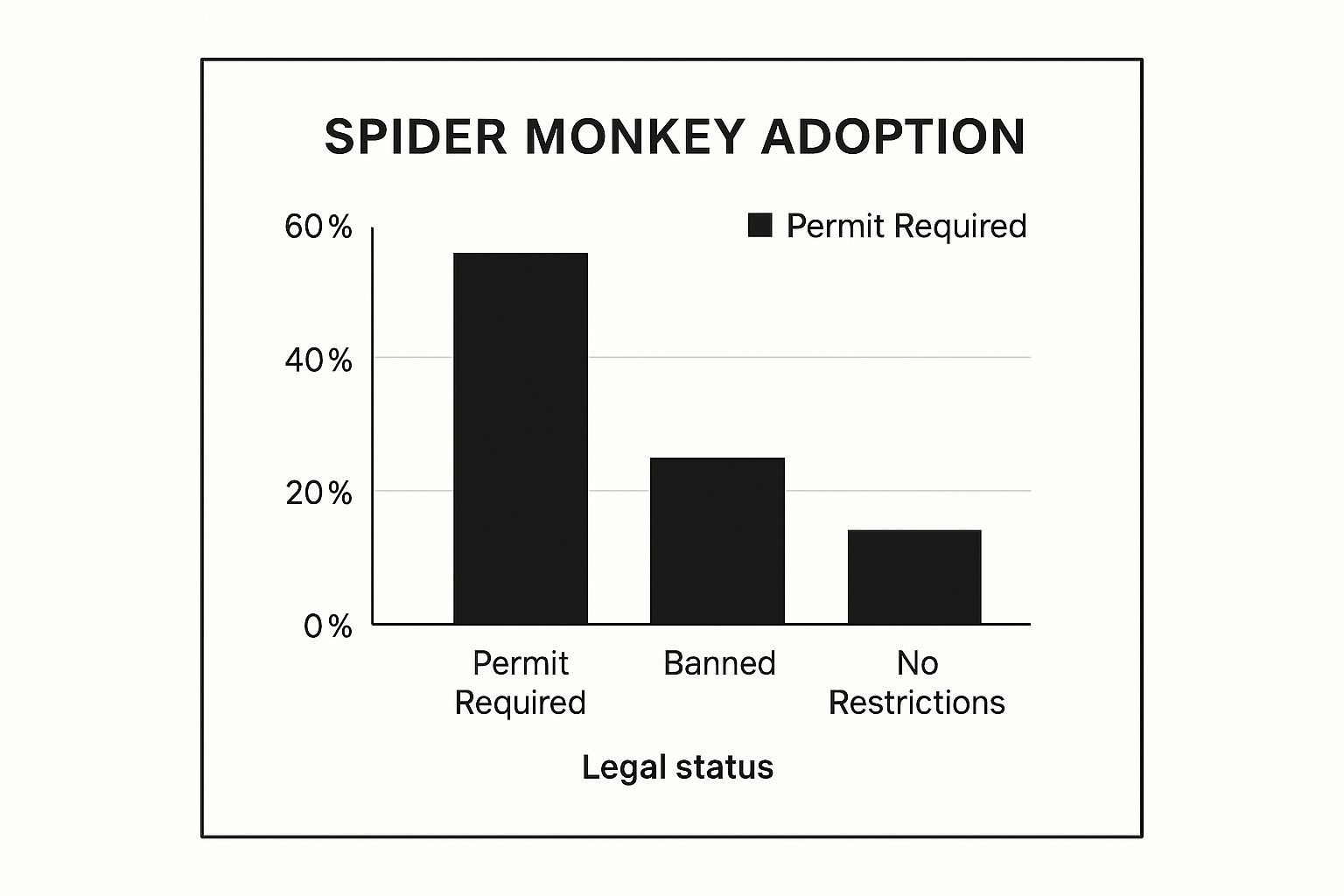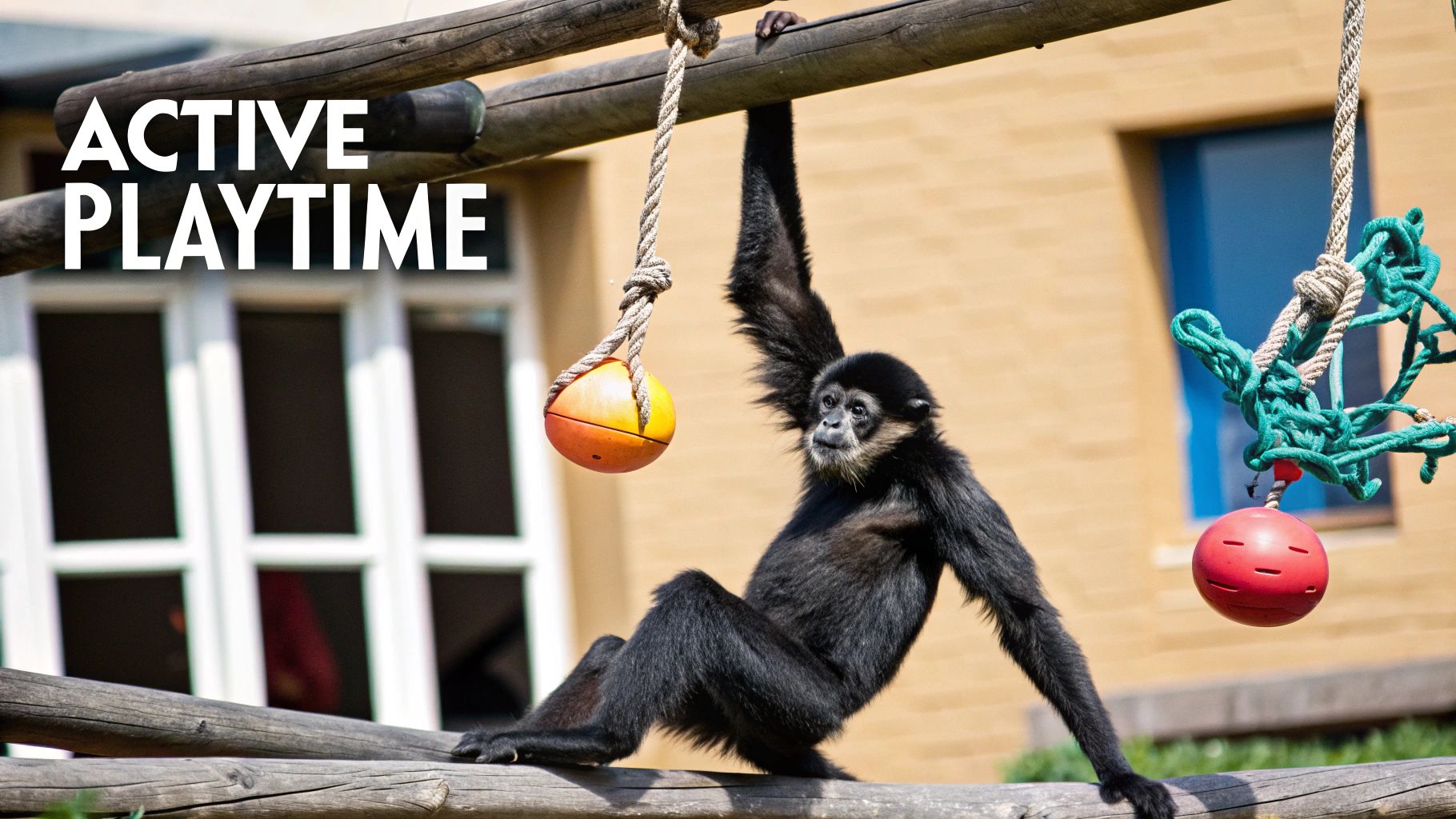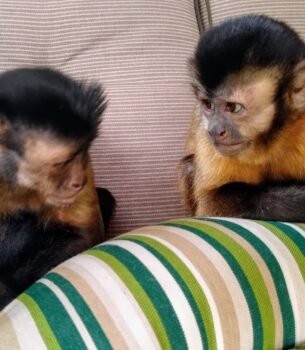Subtotal: $2,350.00

Adopting a Spider Monkey: Ethical Ways to Help Endangered Primates
The Truth About Adopting a Spider Monkey
Spider monkeys, with their intelligence, acrobatic skills, and expressive eyes, are undeniably captivating. The thought of having one swing through your home might seem appealing. But the reality of spider monkey adoption is far more complex and often heartbreaking, both for the monkeys and the well-meaning individuals who seek to own them. Let's explore why bringing a spider monkey into your home is usually a detrimental decision.
The Complex Needs of Spider Monkeys
In their natural habitats, spider monkeys thrive within intricate social structures. These tightly knit family groups provide crucial social interaction, learning, and emotional support, all vital for their well-being. Removing a spider monkey from this environment disrupts this delicate balance, causing significant psychological distress and often leading to behavioral problems. It's similar to a human being suddenly separated from their family and placed in an alien environment—the emotional toll can be devastating.
Furthermore, replicating the specific dietary and environmental requirements of a spider monkey at home is immensely difficult. Their diet in the wild consists of a diverse range of fruits, leaves, flowers, and insects—a delicate balance nearly impossible to duplicate outside their natural habitat. This specialized diet is not easily replaced, and improper nutrition can result in severe health problems.
The Harsh Reality of the Exotic Pet Trade
The desire for spider monkeys as pets unfortunately fuels a cruel and damaging global trade. This trade poses a grave threat to wild spider monkey populations, driven by the high demand for young monkeys as exotic pets. The process of capturing these infants is often brutal. Poachers frequently kill the mother to steal her baby, resulting in the tragic loss of breeding adults and traumatizing the infants. This horrific practice not only deprives young monkeys of their natural upbringing but also inflicts deep psychological wounds, diminishing their chances of survival even if they were returned to the wild. Learn more about the impact of this trade on spider monkeys at the International Fund for Animal Welfare.
Responsible Alternatives to Adoption
While the allure of a spider monkey companion is understandable, the ethical and practical obstacles are substantial. The most effective way to express your admiration for these incredible primates is not through ownership, but through supporting their conservation and protection. Numerous organizations are dedicated to safeguarding spider monkey populations in the wild, and your support can have a real impact. Many offer symbolic adoptions, allowing you to contribute financially to the care and protection of spider monkeys in their natural environments. By supporting these initiatives, you can help ensure a thriving future for these fascinating animals, allowing them to flourish where they truly belong—in the wild. This allows you to contribute to their well-being without disrupting their natural lives.
Why Spider Monkeys Need Our Help Now
Spider monkeys, with their inquisitive nature and effortless grace, are vital to the rainforest's delicate balance. Sadly, these incredible primates face a perilous future. Their numbers are dwindling at an alarming rate, largely due to human activities. Understanding their struggle and supporting conservation efforts is more important than ever.
Habitat Loss and Fragmentation
One of the biggest threats to spider monkeys is the destruction and fragmentation of their rainforest homes. As forests are cleared for agriculture, logging, and development, these primates lose the resources they need to thrive. This habitat loss shrinks their living space and isolates populations, making it harder to find food and mates. This isolation can lead to inbreeding, weakening the species’ ability to adapt.
Hunting and the Illegal Pet Trade
Habitat loss isn't the only danger. Spider monkeys are also hunted for their meat, considered a delicacy in some regions. The illegal pet trade adds another layer of threat. Poachers often kill mother monkeys to capture their infants for sale. This practice is particularly devastating for species like the white-cheeked spider monkey (Ateles marginatus).
The white-cheeked spider monkey is classified as Endangered by the IUCN. Their population is expected to decline by roughly 50% between 2006 and 2050 due to habitat destruction and hunting. In areas with high hunting activity, their population density plummeted by up to 50% between 1987 and 2005. Learn more about their struggle here. This decline creates a ripple effect, impacting the entire rainforest ecosystem. While on the topic of primate care, you might find this article interesting: How to master the marmoset diet.
The Importance of Spider Monkeys in the Ecosystem
Spider monkeys are essential for maintaining the health and biodiversity of rainforests. As highly frugivorous animals, they eat large amounts of fruit, dispersing seeds throughout the forest. This seed dispersal helps maintain plant diversity and ensures the regeneration of the canopy. Their absence would have a devastating impact on plant life and other animals that rely on them.

The infographic above highlights the legal complexities surrounding spider monkey adoption. It shows that 60% of regions require permits, while 25% have banned it entirely. This reflects growing ethical concerns about keeping primates as pets. The remaining 15% with no restrictions underscore the need for stronger conservation efforts and stricter regulations. Even where legal, adopting a spider monkey can unintentionally fuel the harmful practices driving their decline.
To further illustrate the precarious situation of these amazing creatures, let's examine the conservation status of different spider monkey species. The following table provides a detailed overview:
Conservation Status of Spider Monkey Species
This table compares the conservation status and population trends of different spider monkey species
| Species | IUCN Status | Population Trend | Primary Threats | Geographic Range |
|---|---|---|---|---|
| White-cheeked spider monkey (Ateles marginatus) | Endangered | Decreasing | Habitat loss, hunting | Brazil |
| Brown spider monkey (Ateles hybridus) | Critically Endangered | Decreasing | Habitat loss, hunting, pet trade | Colombia, Venezuela |
| Black-headed spider monkey (Ateles fusciceps) | Critically Endangered | Decreasing | Habitat loss, hunting | Panama, Colombia, Ecuador |
| Geoffroy's spider monkey (Ateles geoffroyi) | Endangered | Decreasing | Habitat loss, hunting, pet trade | Central America, Mexico |
| Red-faced spider monkey (Ateles paniscus) | Vulnerable | Decreasing | Habitat loss, hunting | Brazil, Guyana, Suriname, French Guiana |
As the table reveals, various spider monkey species face severe threats, with several classified as Critically Endangered or Endangered. Habitat loss and hunting remain the primary drivers of their decline, emphasizing the urgent need for continued conservation efforts.
Symbolic Adoption: How Your Support Makes a Real Impact
Want to make a difference in the lives of spider monkeys but feel unsure how? Symbolic adoption offers a powerful and ethical avenue to contribute directly to their well-being. Unlike attempting to keep a spider monkey as a pet—often harmful, legally complicated, and detrimental to the animal—symbolic programs center on supporting these primates in their natural environments.
Making a Real Difference From Afar
Symbolic adoption isn’t about bringing a monkey home; it's about providing essential resources for their care and safeguarding their future. These programs allow you to contribute financially to organizations actively protecting spider monkeys in the wild. Your donations have a tangible impact, funding critical initiatives that protect these fascinating creatures and their delicate rainforest habitats.
For instance, symbolic adoption programs frequently support habitat preservation, acquiring and safeguarding land vital to spider monkey survival. Your donations can also fund anti-poaching initiatives, combating the illegal pet trade that decimates spider monkey populations. Furthermore, symbolic adoption can cover rescue and rehabilitation costs for injured or orphaned monkeys, offering them a second chance.
Organizations like the Toucan Rescue Ranch offer symbolic adoptions where your contribution directly supports the care of rescued spider monkeys. This covers food, medical care, and rehabilitation for monkeys confiscated from the illegal pet trade or rescued from habitat destruction, contributing to the survival of individual animals. Learn more about their program here.
Choosing the Right Program and Getting Involved
There are several ways to participate in symbolic adoption. You can make one-time donations or choose ongoing sponsorships, receiving regular updates on the specific monkey or project you're supporting. Some programs offer personalized adoption certificates and educational resources, deepening your connection with the animals you're helping.

When selecting a program, research the organization to ensure its reputation and transparency regarding donation usage. Seek out organizations with a proven track record in spider monkey conservation. This careful selection is crucial for maximizing the impact of your contribution and supporting the long-term survival of these incredible primates. For those interested in learning about responsible pet ownership, exploring resources like this blog post on pygmy marmosets can be informative.
Levels of Giving and Their Impact
Different contribution levels often provide varying benefits. A small donation can feed a monkey for a week, while a larger contribution might purchase essential medical equipment or help protect a section of rainforest. Understanding these levels lets you choose the option that best suits your budget and desired impact. Regardless of the size, knowing how your donation makes a difference strengthens your connection to spider monkey conservation, fostering a sense of shared responsibility and encouraging continued support.
Navigating the Legal Landscape of Spider Monkey Adoption

The allure of a spider monkey as a pet is undeniable. Their intelligence, playful nature, and expressive eyes can easily capture our hearts. However, the dream of sharing your life with a spider monkey often clashes with a stark reality: the complex and frequently restrictive legal landscape surrounding their ownership. It's crucial to understand these regulations, not only to avoid legal trouble but also to contribute to the wellbeing of these fascinating creatures.
International Agreements and Federal Regulations
Spider monkeys are afforded protection under the Convention on International Trade in Endangered Species of Wild Fauna and Flora (CITES). This international treaty regulates the trade of endangered species, including spider monkeys, with the ultimate goal of preventing their extinction. This often translates into strict controls on importing and exporting these primates across international borders, typically requiring permits and a mountain of paperwork.
Many countries also enforce national laws that either restrict or entirely prohibit spider monkey ownership. In the United States, the Endangered Species Act (ESA) plays a vital role in safeguarding endangered primates, including several species of spider monkeys. The ESA makes it illegal to buy, sell, or even possess these endangered species without the proper permits.
State and Local Laws: A Patchwork of Regulations
Adding another layer of complexity, state and local laws create a varied tapestry of restrictions on spider monkey ownership. Some states impose outright bans on private ownership, while others may require specialized permits. This patchwork of regulations underscores the importance of diligently researching the specific rules in your locality before even entertaining the idea of welcoming a spider monkey into your home. Just as clear communication is vital for web design, as discussed in this article on contact page design, clarity on legal matters is paramount here.
Penalties and the Importance of Compliance
Ignoring these laws can lead to serious consequences. The penalties can include significant fines, the confiscation of the animal, and even jail time. However, compliance extends beyond simply avoiding punishment. It's about contributing to responsible wildlife stewardship. These regulations exist to protect both the animals and the public. While undeniably intelligent and captivating, spider monkeys can present safety risks in a domestic environment.
To better illustrate the legal variations, the following table provides a regional overview:
Legal Status of Spider Monkey Ownership by Region
This table outlines the varying legal restrictions on spider monkey ownership across different countries and regions
| Region/Country | Ownership Status | Permit Requirements | Penalties for Violation | Recent Legal Changes |
|---|---|---|---|---|
| United States | Varies by state; generally restricted or prohibited for endangered species | Often requires permits under the ESA and may vary by state | Fines, confiscation of the animal, potential jail time | Ongoing revisions at state level |
| European Union | Generally restricted; requires special permits and adherence to CITES regulations | Varies by country but generally stringent | Fines, confiscation, potential legal action | Increased focus on welfare and traceability |
| Central & South America | Many countries have restrictions or bans due to conservation concerns | May be possible with special permits, but generally discouraged | Varies widely, often including fines and confiscation | Increased enforcement due to illegal pet trade |
| Asia | Mostly prohibited due to CITES and national laws | Permits rarely granted | Significant penalties, including imprisonment | Stronger focus on combating illegal wildlife trade |
As demonstrated in the table, acquiring a spider monkey is a complex process that differs greatly depending on location. It is crucial to research your specific region’s laws to ensure compliance and contribute to the ethical treatment of these animals.
Why These Laws Exist
These legal frameworks are in place for a multitude of reasons. They are designed to prevent the exploitation of endangered species, combat the illegal pet trade, and ensure the proper care of animals with specialized needs. Recognizing that certain animals, like spider monkeys, are not suited for domestic life, they also exist to protect the public from potential harm. By understanding and respecting these regulations, we contribute to a more sustainable future for spider monkeys, ensuring their survival in the wild—where they truly belong.
Inside Spider Monkey Sanctuaries: The Real Heroes

Genuine spider monkey sanctuaries are more than just rescue centers. They represent a vital lifeline for these intelligent and sensitive primates, offering a beacon of hope for displaced, injured, or confiscated spider monkeys. The specialized care provided goes far beyond basic food and shelter. Let's explore the invaluable work of these sanctuaries and how to identify authentic organizations.
Creating a Haven: Specialized Habitats and Social Groups
Rescued spider monkeys often arrive with varying degrees of trauma. Many are victims of the illegal pet trade, taken from their mothers at a young age and denied crucial social development. Sanctuaries work tirelessly to recreate environments mirroring the spider monkeys' natural habitat. This includes constructing spacious enclosures with climbing structures and enrichment activities to stimulate their natural behaviors.
But a physical environment isn't enough. Spider monkeys are intensely social. Sanctuaries understand this and meticulously create appropriate social groups, introducing monkeys gradually and carefully observing their interactions. This careful social integration allows rescued monkeys to rebuild their lives within a supportive community, much like their family groups in the wild.
Rehabilitation and Enrichment: Nurturing Minds and Bodies
Rehabilitation is central to the work of genuine spider monkey sanctuaries. This involves addressing both physical and psychological needs. Some monkeys arrive malnourished, injured, or suffering from stress-related illnesses. Specialized veterinary care, dietary management, and even behavioral therapy are critical.
Sanctuaries also implement enrichment programs. These programs stimulate the monkeys' cognitive abilities and encourage natural foraging behaviors. Puzzle feeders, hidden treats, and opportunities to explore new objects and environments are all part of this approach.
This focus on both physical and mental well-being gives rescued monkeys the best chance to heal and truly thrive. The goal surpasses mere survival. Sanctuaries strive to restore these primates to a level of health and psychological stability where they can live fulfilling lives. This dedicated care contrasts sharply with the neglect and isolation many of these animals experienced in captivity.
Supporting True Sanctuaries: Ethical Engagement and Meaningful Contributions
Sadly, not all facilities claiming to rescue spider monkeys operate ethically. Some prioritize profit over animal welfare, disguising exploitative practices as conservation. It's essential to differentiate true sanctuaries from less reputable establishments. Authentic sanctuaries prioritize the monkeys’ well-being above all else. They restrict public interaction to minimize stress and maintain a peaceful environment.
Ethical sanctuaries also emphasize education and conservation, raising awareness about the plight of spider monkeys in the wild and the importance of protecting their rainforest habitats. You can support these organizations through financial contributions, volunteering your time, or spreading awareness. Meaningful support goes beyond a simple donation. It involves actively engaging with the sanctuary's mission and becoming an advocate for spider monkey conservation. For example, consider symbolic adoption programs. These provide essential funding for the care and rehabilitation of rescued monkeys while contributing to broader conservation efforts. By supporting genuine sanctuaries, you contribute to a brighter future for these remarkable primates.
Connecting With Spider Monkeys: Ethical Engagement Options
Want to experience the magic of spider monkeys without contributing to their exploitation? Thankfully, plenty of ethical ways exist to connect with these incredible primates and directly support their conservation. Let's explore some enriching alternatives to adopting a spider monkey, focusing on opportunities that benefit both you and these endangered animals.
Experiencing Spider Monkeys in Their Natural Habitat
One of the most rewarding ways to connect with spider monkeys is by observing them in their natural environment. Ethical tourism offers amazing chances to witness these acrobatic primates swinging through the rainforest canopy. Be sure to choose tour operators dedicated to sustainable practices that minimize environmental impact and respect local communities. These guided experiences not only provide unforgettable encounters but also contribute financially to crucial habitat preservation and ongoing conservation efforts. Some eco-lodges even partner with research organizations, allowing you to learn directly from experts while supporting their important work. This type of immersive experience provides genuine insight into the spider monkey’s essential role in the rainforest ecosystem.
Visiting Legitimate Sanctuaries: A Sanctuary, Not a Zoo
Visiting accredited sanctuaries offers another ethical way to encounter spider monkeys. These organizations rescue and rehabilitate monkeys confiscated from the illegal pet trade or displaced by habitat loss. It's vital, however, to distinguish true sanctuaries from exploitative attractions. Genuine sanctuaries prioritize animal welfare over entertainment, offering limited and respectful visitor access. Look for organizations focused on creating naturalistic environments, providing enrichment programs, and working towards reintroduction when possible. Supporting these sanctuaries through visits and donations directly contributes to their vital work, offering a lifeline for spider monkeys in need.
Educational Resources: Expanding Your Knowledge
You don't have to travel to the rainforest to connect with spider monkeys. Numerous educational resources offer fascinating insights into their behavior, ecology, and the challenges they face. Immersive documentaries can transport you to their world, revealing their complex social dynamics and the threats to their survival. Citizen science projects provide opportunities to contribute directly to research efforts, perhaps analyzing data or monitoring populations remotely. These engaging experiences deepen your understanding of spider monkeys while supporting vital conservation initiatives. Educational programs offered by zoos and conservation organizations also serve as valuable tools for fostering appreciation and promoting responsible wildlife stewardship.
Empowering Local Communities: Conservation Through Sustainable Livelihoods
Conservation is closely tied to the well-being of local communities. Many communities living near spider monkey habitats are developing sustainable livelihoods through ecotourism and other conservation projects. By supporting these efforts—purchasing locally made crafts, participating in community-based tourism, or donating to organizations that empower local people—you contribute to both economic development and wildlife protection. This collaborative approach creates a positive ripple effect, fostering shared responsibility for protecting these amazing primates and their rainforest homes. Some communities, for example, develop cooperatives that produce sustainable goods from rainforest resources, generating income while reducing deforestation pressures.
Inspiring Future Generations: Family-Friendly Engagement
Inspiring the next generation of conservationists is vital for the long-term survival of spider monkeys. Many conservation organizations offer family-friendly programs that engage children with interactive exhibits, educational games, and hands-on activities. These experiences foster a sense of wonder and respect for wildlife, nurturing future conservation efforts. By encouraging children to learn about spider monkeys and their crucial role in the rainforest, we empower them to become advocates for their protection. This instills a life-long appreciation for these remarkable creatures and the vital importance of preserving their natural habitats.
Ready to explore the fascinating world of primates and find your perfect companion? Visit PrimatePet today to discover a diverse selection of exotic animals and learn about responsible pet ownership.
Article created using Outrank





 Java macaque Monkeys For Sale
Java macaque Monkeys For Sale